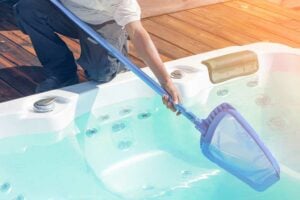One of the most aggravating swimming pool maintenance issues is algae. Although it’s fairly common, there are different types of algae, some more stubborn than others. Learning about the different kinds of algae and how to remove them will get your pool back to the oasis you deserve.
Green Algae
Green algae are the most common type of pool algae. It turns your pool water green and cloudy, but it’s also the easiest to remove. Follow these steps to kick that algae to the curb.
- Use a pool brush and scrub the floor, walls, and ladder. Pay close attention to where algae have already grown.
- Add shock and algaecide if necessary. It’s best to check with your pool professional about the amount of chemicals to add.
- Allow the filter to run and circulate the chemicals for a day or two.
- Brush the walls and floor of the pool again.
- Vacuum up and backwash the algae.
- Take your water to a pool professional and have it tested. At this point, your water should be in good shape but your pool professional will be able to guide you and tweak any chemicals still needed.
Mustard Algae
Mustard algae is a type of algae that can be resistant to chlorine. It’s a yellow-brown color that resembles dirt and often appears near ladders and lights. Removing mustard algae follows the same steps as green algae, but it can easily reappear if everything is not cleaned thoroughly. This means all maintenance equipment and pool toys. Simply add these items into the pool during the treatment to rid all equipment of mustard algae.
Black Algae
Appearing in black spots around the pool and even in the filter, this is the toughest type of algae to remove. The general steps to remove black algae are the same as green algae but you may need to brush and vacuum several times until it comes off.
Algae can put a damper on your pool plans for the day but it can be removed with a bit of time and effort. If you have any questions or need help, please contact us.



 by
by 
